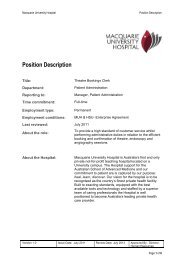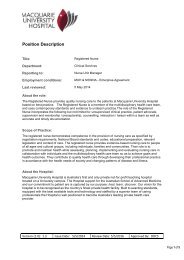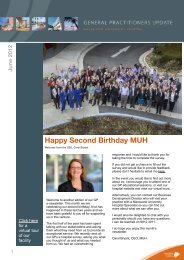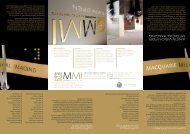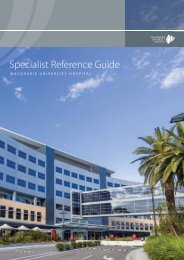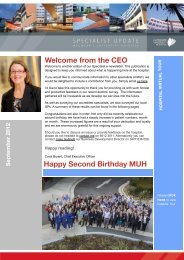Plenary Oral Presentations - Macquarie University Hospital
Plenary Oral Presentations - Macquarie University Hospital
Plenary Oral Presentations - Macquarie University Hospital
You also want an ePaper? Increase the reach of your titles
YUMPU automatically turns print PDFs into web optimized ePapers that Google loves.
16 th International Meeting of the Leksell Gamma Knife ® SocietyMarch 2012, Sydney, AustraliaPH-291TMR 10: A comparison with TMR classic forclinical treatment plans1,2,3,4Ian Paddick, 5 Jonas Johansson1Cromwell <strong>Hospital</strong> Gamma Knife Centre,, London, UK2London Gamma Knife Centre, Barts <strong>Hospital</strong>, London, UK3Thornbury Radiosurgery Centre, Sheffield, UK4St. Elisabeth Gamma Knife, Tilburg, Netherlands5Elekta Instrument AB, Stockholm, SwedenObjective: Leksell GammaPlan 10.0 introduced an improved dose calculation algorithm, TMR 10,which entails new beam profiles, depth doses and output factors. This enhanced beam modelling hasmade inaccuracies of the previous algorithm, TMR Classic, apparent. Furthermore, multi-isocentricplanning techniques can amplify subtle differences in single shot profiles, which in turn can affectthe dose calculated, normalisation and beam on time. We aimed to quantify dosimetrical differencesbetween the two algorithms.Methods: 30 targets planned with TMR Classic for the Leksell Gamma Knife ® Perfexion (PFX)were retrospectively re-calculated using the TMR 10 algorithm. This method was repeated for 37targets planned for the Model B/C. The maximum dose, the mean dose to the target, and themaximum dose to the organs at risk (OARs) were compared.In a non-clinical investigation, the greatest dose discrepancy possible between the two algorithmswas also explored.Results: Assuming that TMR 10 correctly calculates dose to the skull, TMR Classic generallyunderestimated maximum Perfexion doses by 2.0% (range: -3.3% to 6.7%), mean doses 1.5%(range: -2.0% to 5.3%) and OARs 3.6% (range: -3.9 to 7.1%).Model B/C data differed by less. TMR Classic underestimated maximum doses by an average of 1.2%(range: -0.7% to 4.2%), mean doses 0.9% (range: -1.3% to 2.7%) and overestimated OARs by 1.8%(range: -0.9% to 4.5%).In a non-clinical setting, the largest discrepancy was for a plan with 8mm and 16mm shots withidentical x and y coordinates, but with the 8mm shot placed 13.0mm in the superior direction. TMRClassic recorded a maximum dose 18.1% lower than that of TMR 10.Conclusion: Dosimetrical differences between the two algorithms can be significant in certain circumstances.Fortunately, dose differences between TMR Classic for Model B/C (where most of our empiricaldata lies) and TMR 10 is minimal. Doses to OARs were typically underestimated by TMR Classic forPFX, but overestimated for the Model B/C. As a result, some users may be unintentionally giving dosesto OARs that are several percent higher with PFX. When quoting doses to critical structures with clinicalresults, users should recalculate the doses delivered using TMR 10.68



